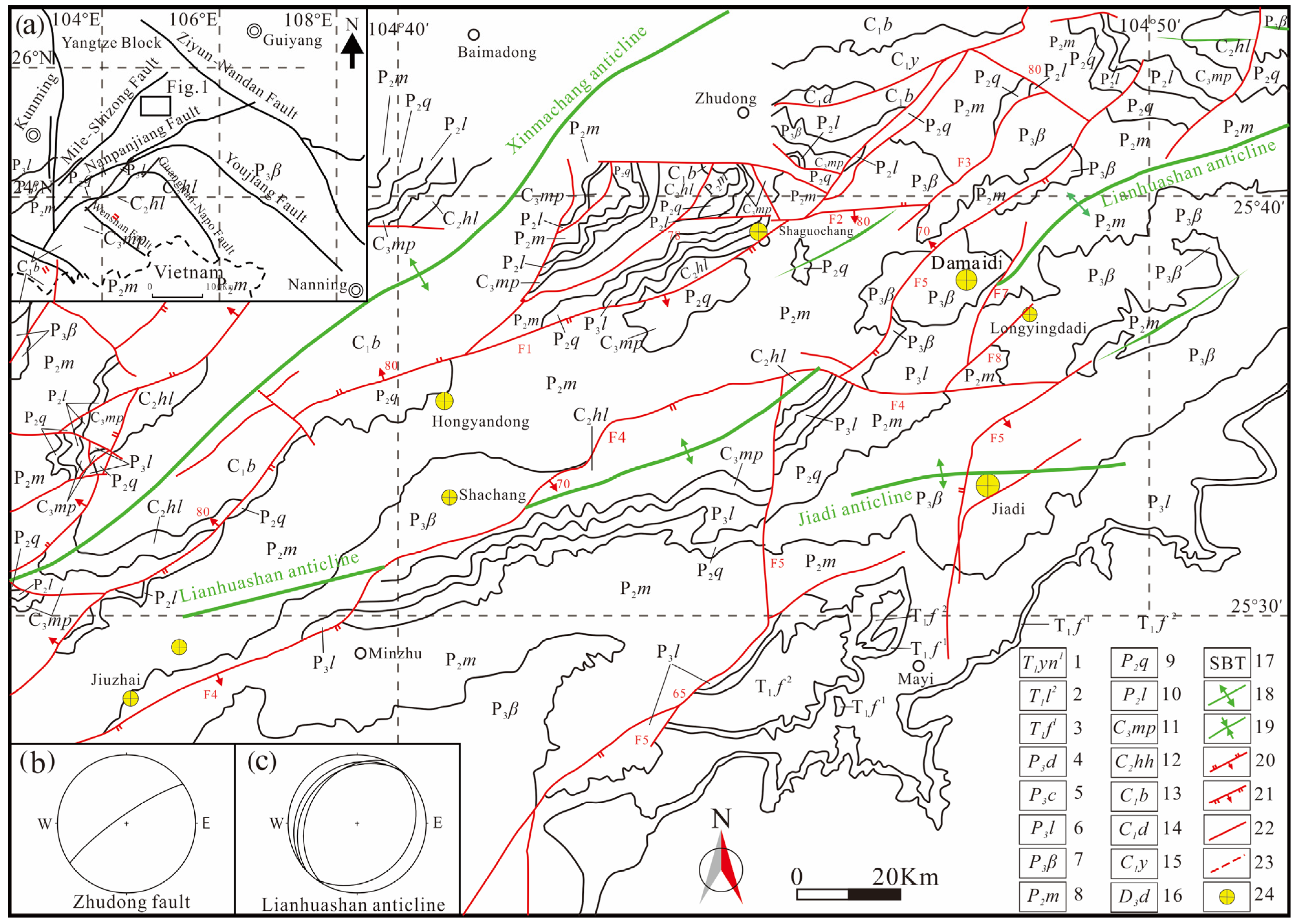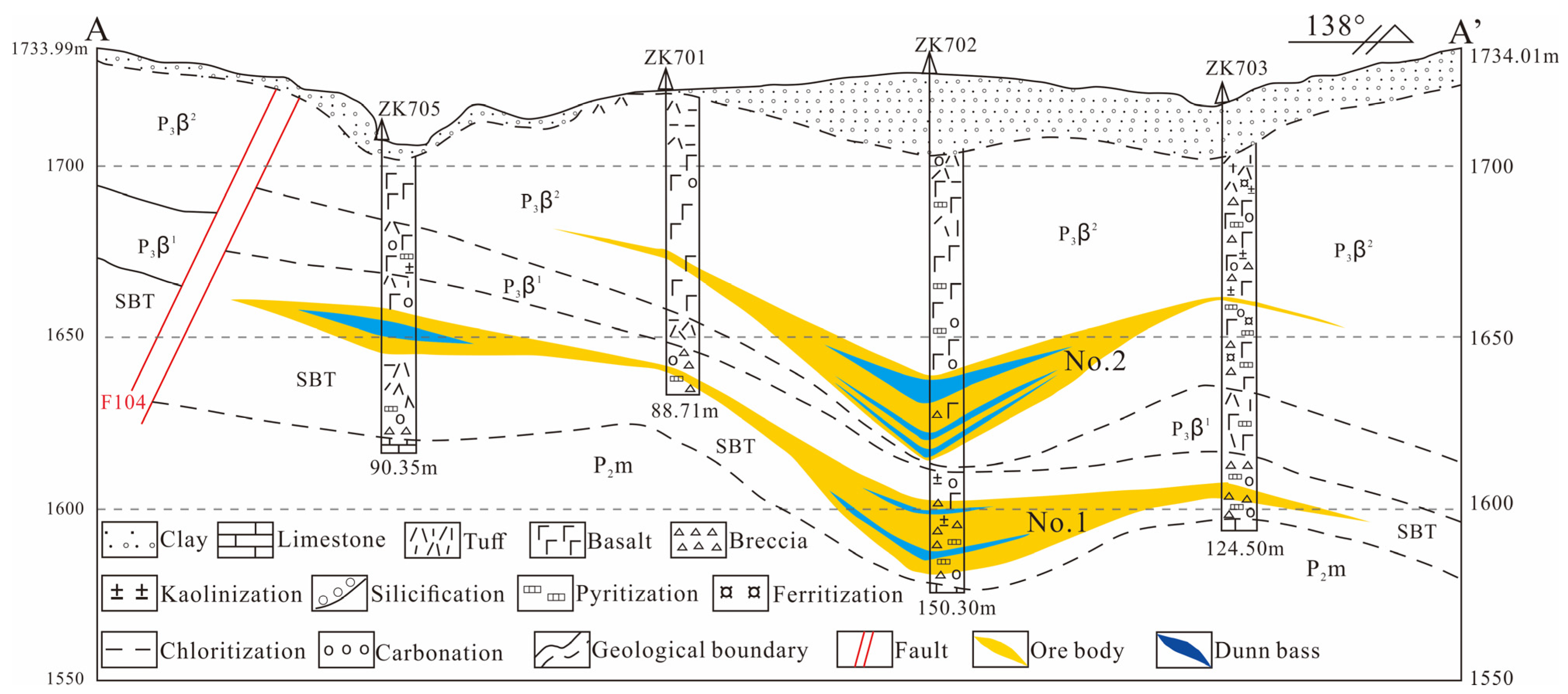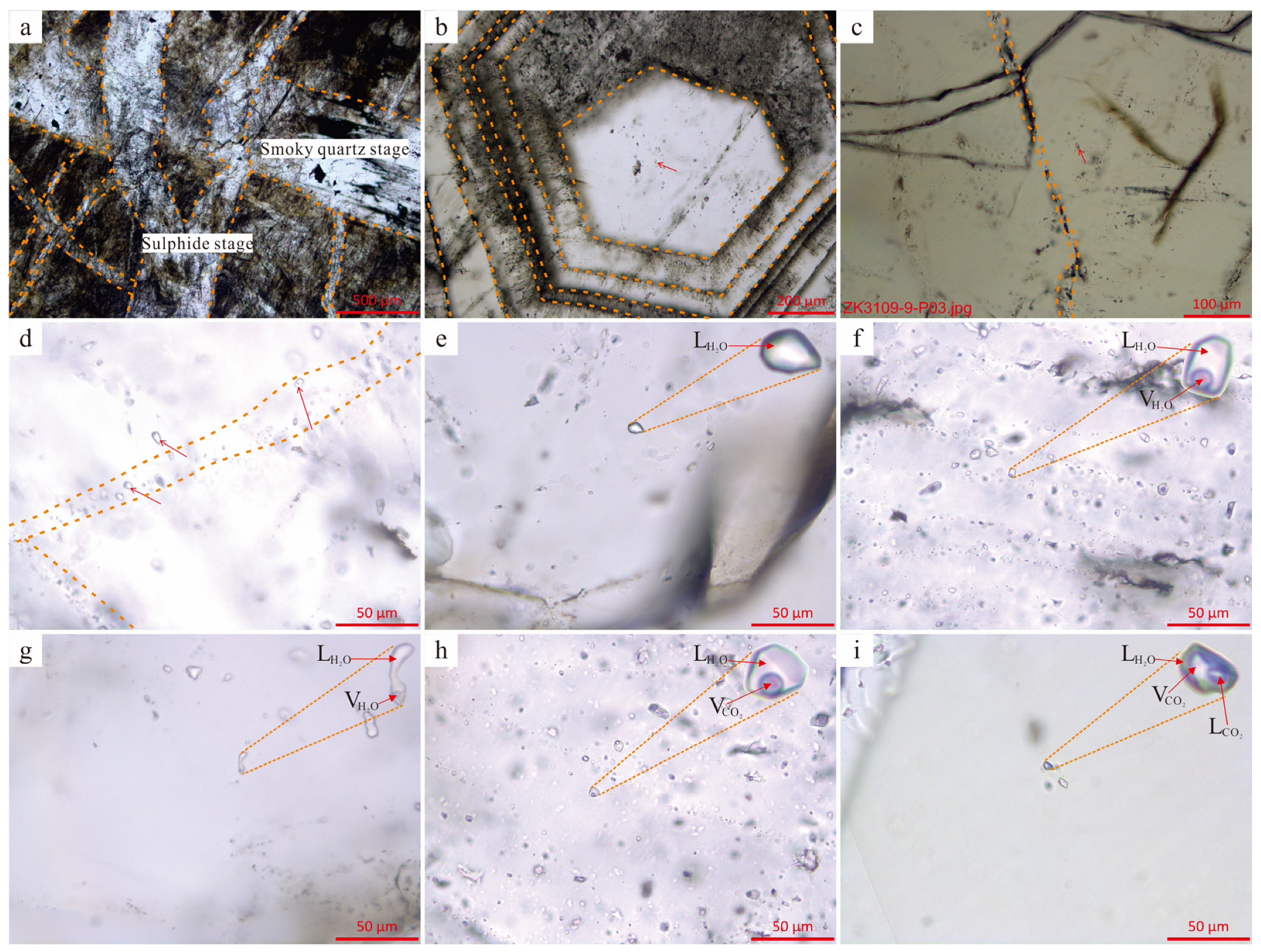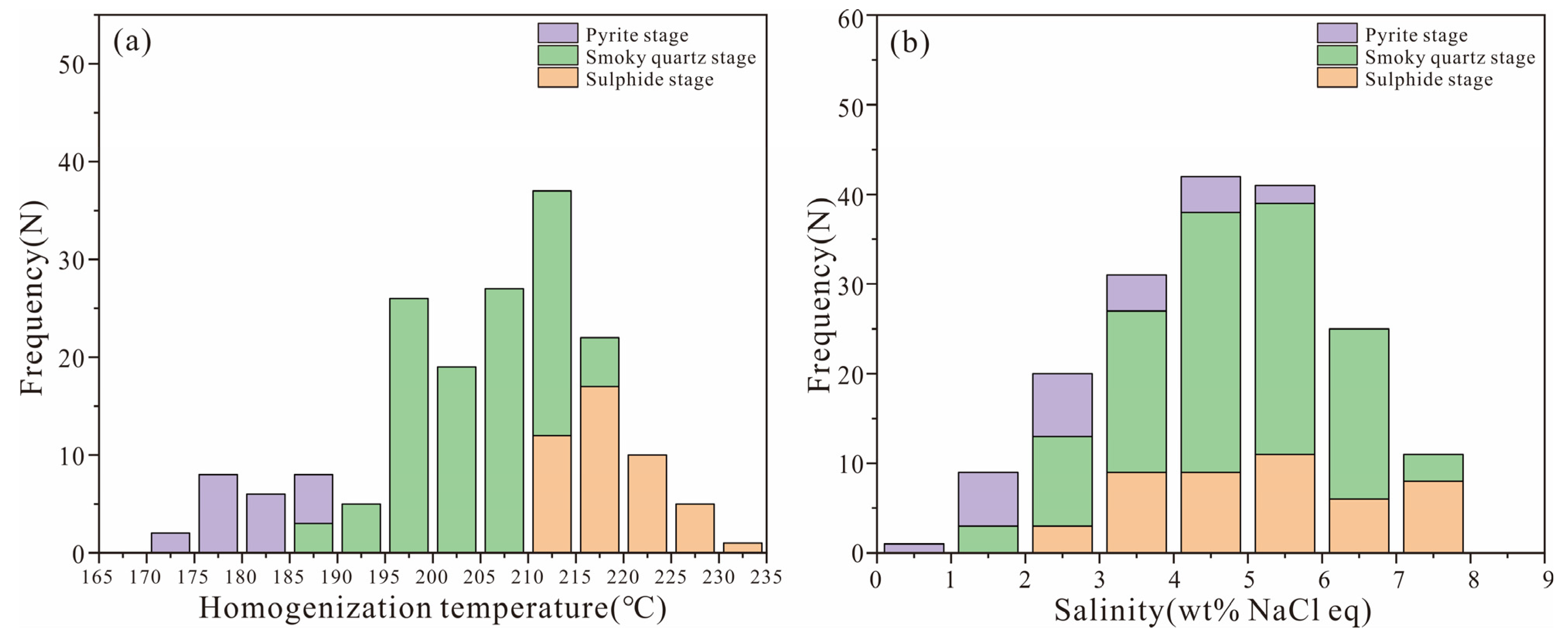Structure–Fluid–Mineralization System of Jiadi Gold Deposit in Southwestern Guizhou, China
Abstract
:1. Introduction
2. Geological Setting
3. Geological Characteristics of Deposit
4. Characteristics of Ore-Controlling Structure
4.1. Characteristics of Structural Deformation
- (1)
- Fold structure
- (2)
- Fault structure
4.2. Regional Tectonic Evolution
5. Fluid Inclusion
5.1. Sample Collection
5.2. Fluid Inclusion Petrography
- (1)
- NaCl-H2O type inclusions (A)
- (2)
- CO2-NaCl-H2O type inclusions (B)
5.3. Microthermometry of the Fluid Inclusions
5.4. Laser Raman Spectroscopy (LSR) Analysis
6. Stable Isotope Geochemistry
6.1. Sample Collection and Analysis Method
6.2. Carbon and Sulfur (C-S) Isotope Geochemistry
6.3. Hydrogen and Oxygen (H-O) Isotopes Geochemistry
7. Discussion
7.1. Ore-Forming Fluid and Gold Mineralization
7.2. Tectonic Activity and Gold Mineralization
7.3. Structure–Fluid Coupling Mineralization
8. Conclusions
Author Contributions
Funding
Data Availability Statement
Conflicts of Interest
References
- Xie, X.Y.; Feng, D.S.; Chen, M.H.; Guo, S.X.; Kuang, S.D.; Chen, H.S. Fluid inclusion and stable isotope geochemistry study of the Nibao gold deposit, Guizhou and insights into ore genesis. Acta Petrol. Sin. 2016, 32, 3360–3376. (In Chinese) [Google Scholar]
- Li, X.; Zhou, Z.G.; Zhang, M.F.; Jin, Y.J. Geological characteristics and ore-controlling structure of jiadi gold deposit in Lianhuashan area, Guizhou Province. Acta Mineral. Sin. 2015, 35, 223–224. (In Chinese) [Google Scholar] [CrossRef]
- Liu, J.Z.; Deng, Y.M.; Liu, C.Q.; Zhang, X.C.; Xia, Y. Metallogenic conditions and model of the superlarge Shuiyindong stratabound gold deposit in Zhenfeng County, Guizhou Province. Geol. China 2006, 33, 169–177. (In Chinese) [Google Scholar] [CrossRef]
- Wang, D.F. Preliminary Study on Geological and Geochemical Characteristics of Jiadi Gold Deposit in Panxian, Guizhou Province. Master’s Thesis, Guizhou University, Guiyang, China, 2015; pp. 32–44. (In Chinese). [Google Scholar]
- Chen, M.H.; Mao, J.W.; Qu, W.J.; Wu, L.L.; Uttley, P.J.; Norman, T.; Zheng, J.M.; Qin, Y.Z. Re-Os dating of arsenian pyrites from the Lannigou gold deposit, Zhenfeng, Guizhou Province, and its geological significances. Geol. Rev. 2007, 53, 371–382. (In Chinese) [Google Scholar] [CrossRef]
- Xiao, D.Z. The Study on Ore-Forming Fluids in the Yata Carlin-Type Gold Deposit, Guizhou Province. Ph.D. Thesis, Chengdu University of Technology, Chengdu, China, 2012; pp. 37–43. (In Chinese). [Google Scholar]
- Chen, M.H.; Mao, J.W.; Bierlein, F.P.; Norman, T.; Uttley, P.J. Structural features and metallogenesis of the Carlin-type Jinfeng (Lannigou) gold deposit, Guizhou Province, China. Ore Geol. Rev. 2011, 43, 217–234. [Google Scholar] [CrossRef]
- Chen, M.H.; Huang, Q.W.; Li, J.X.; Jiang, B.C.; Zhang, C.M. Structure analysis and structural metallogenesis of the Linwang gold deposit, Leye, Guangxi, China. Geotecton. Metallog. 2010, 34, 349–361. (In Chinese) [Google Scholar] [CrossRef]
- Wu, S.Y.; Hou, L.; Ding, J.; Wu, W.; Qin, K.; Zhang, J.R.; Zhu, S.B. Ore-controlling structure types and characteristics of ore-forming fluid of the Carlin-type gold orefield in southwestern Guizhou, China. Acta Petrol. Sin. 2016, 32, 2407–2424. (In Chinese) [Google Scholar]
- Berger, B.R.; Tingley, J.V.; Drew, L.J. Structural localization and origin of compartmentalized fluid flow, Comstock Lode, Virginia City, Nevada. Econ. Geol. 2003, 98, 387–408. [Google Scholar] [CrossRef]
- Simmons, S.F.; Brown, K.L. Gold in magmatic hydrothermal solutions and the rapid formation of a giant ore deposit. Science 2006, 314, 288–291. [Google Scholar] [CrossRef]
- Zhai, Y.S. Some preblems on the study of ore field structures. Geol. Rev. 1984, 30, 19–25. (In Chinese) [Google Scholar]
- He, J.P.; Yuan, S.F.; Wang, X.Y.; Pian, H.Y. Geochemical Characteristics of the Lianhuashan Anticline in the Southwest Guizhou Dense Area of Mineral Deposits. Acta Geol. Sichuan 2018, 38, 384–397. [Google Scholar] [CrossRef]
- Zeng, G.P.; Luo, D.W.; Gong, Y.J.; Hu, X.L.; Li, H. Structures and implications for fluid migration in the Jiadi Carlin-type gold deposit, Guizhou Province, Southwest China. Resour. Geol. 2018, 68, 373–394. [Google Scholar] [CrossRef] [Green Version]
- Xia, Y.; Zhang, Y.; Su, W.C.; Tao, Y.; Zhang, X.C.; Liu, J.Z.; Deng, Y.M. Metallogenic model and prognosis of the Shuiyindong super-large stratabound Carlin-type gold deposit, Southwestern Guizhou Province, China. Acta Geol. Sin. 2009, 83, 1473–1482. (In Chinese) [Google Scholar] [CrossRef]
- Li, B.H.; Gu, X.Y.; Fu, S.H.; Xu, S.H.; Chen, C.H.; Dong, S.Y. The evidence from fluid inclusions for the immiscibility of the ore-forming fluids in the Shuiyindong gold deposit, Guizhou Province. Earth Sci. Front. 2010, 17, 286–294. (In Chinese) [Google Scholar]
- Peng, Y.W.; Gu, X.X.; Liu, L.; Cheng, W.B. Fluid inclusion characteristics and implications to mineralization in the Zimudang gold deposit in Southwest Guizhou Province, China. Acta Mineral. Sin. 2012, 32, 211–220. (In Chinese) [Google Scholar] [CrossRef]
- Zhao, F.Y.; Xiao, C.G.; Zhang, B.Q.; Wang, S.H.; Li, J.H.; Ma, J. REE and isotopic features of the Jiadi gold deposit in Panxian county of Guizhou province and its ore-forming material source. Geol. Explor. 2018, 54, 465–478. (In Chinese) [Google Scholar]
- Zeng, G.P. Study on the Structurally Controlling on the Micro-Disseminated Gold Deposits in the Western of the Southwest Guizhou Gold Ore Concentration Area. Ph.D. Thesis, China University of Geosciences, Wuhan, China, 2018; pp. 38–46. [Google Scholar]
- Wang, D.H.; Chen, Y.C.; Tang, J.X.; Ying, L.J.; Wang, C.H.; Liu, S.B.; Li, L.X.; Qin, Y.; Li, H.Q.; Qu, W.J.; et al. New data of the rock-forming and ore-forming chronology for China’s important mineral resources areas. Acta Geol. Sin. 2010, 84, 1030–1040. (In Chinese) [Google Scholar]
- Xia, Y. Characteristics and Model for Shuiyindong Gold Deposit in Southwestern Guizhou, China. Ph.D. Thesis, Institute of Geochemistry, Chinese Academy of Sciences, Guiyang, China, 2005; pp. 36–50. (In Chinese). [Google Scholar]
- Yan, D.P.; Zhou, M.F.; Song, H.L.; John, M. Where was South China located in the reconstruction of Rodinia? Earth Sci. Front. 2002, 9, 249–256. (In Chinese) [Google Scholar] [CrossRef]
- Wu, F.Y.; Ge, W.C.; Sun, D.Y.; Guo, C.L. Discussions on the lithospheric thinning in Eastern China. Earth Sci. Front. 2003, 10, 51–60. (In Chinese) [Google Scholar]
- Lehrmann, D.J.; Payne, J.L.; Pei, D.H.; Enos, P.; Druke, D.; Steffen, K.; Zhang, J.Y.; Wei, J.Y.; Orchard, M.J.; Ellwood, B. Record of the end-Permian extinction and Triassic biotic recovery in the Chongzuo-Pingguo platform, Southern Nanpanjiang basin, Guangxi, South China. Palaeogeogr. Palaeoclimatol. Palaeoecol. 2007, 252, 200–217. [Google Scholar] [CrossRef]
- Hua, R.M.; Chen, P.R.; Zhang, W.L.; Lu, J.J. Three major metallogenic events in Mesozoic in South China. Miner. Depos. 2005, 24, 99–107. (In Chinese) [Google Scholar] [CrossRef]
- Hu, Y.; Liu, W.; Wang, J.J.; Zhang, G.Q.; Zhou, Z.Z.; Han, R.S. Basin-scale structure control of Carlin-style gold deposits in central Southwestern Guizhou, China: Insights from seismic reflection profiles and gravity data. Ore Geol. Rev. 2017, 91, 444–462. [Google Scholar] [CrossRef]
- Tian, C.; Zhang, W.G.; He, H.J.; Yang, X.K.; Han, K.; Wang, X.H. Mineralogical characteristics of gold-bearing pyrite and gold occurrence regularity of the Jiadi gold deposit in southwestern Guizhou Province. Geol. China 2020, 1, 1–19. (In Chinese) [Google Scholar]
- Liu, J.Z.; Xia, Y.; Deng, Y.M.; Su, W.C.; Zhang, X.C.; Qiu, L.; Chen, M.; Chen, F.E.; Fu, Z.K. Researches on the Sbt of Shuiyindong gold deposit and significance for regional prospecting. Gold Sci. Technol. 2009, 17, 1–5. (In Chinese) [Google Scholar] [CrossRef]
- Zhang, H.T.; Su, W.C.; Tian, J.J.; Liu, Y.P.; Liu, J.Z.; Liu, C.Q. The Occurrence of Gold at Shuiyindong Carlin-type Gold Deposit, Guizhou. Acta Mineral. Sin. 2008, 1, 17–24. [Google Scholar] [CrossRef]
- Williams, P.F. Multiply deformed terrains—Problems of correlation. J. Struct. Geol. 1985, 7, 269–280. [Google Scholar] [CrossRef]
- Allmendinger, R.W.; Cardozo, N.; Fisher, D. Structural Geology Algorithms: Vectors and Tensors in Structural Geology; Cambridge University Press: Cambridge, UK, 2012; pp. 36–50. [Google Scholar] [CrossRef]
- Cao, H.S. A discussion on the environment and minerogenesis of “Dachang Strata” in Southwest Guizhou. Guizhou Geol. 1991, 26, 5–13. (In Chinese) [Google Scholar]
- Li, J.H. The Study of Ore-Forming Processes of the Jiadi and Damaidi Basalt-Hosted Gold Deposits, Southwestern Guizhou Province, China. Ph.D. Thesis, Guizhou University, Guiyang, China, 2021; pp. 40–44. (In Chinese). [Google Scholar]
- Li, X.G. Mesozoic structural Deformation Characteristics and Superposition Pattern in Southwest Guizhou, China. Master’s Thesis, China University of Geosciences, Wuhan, China, 2012; pp. 30–38. (In Chinese). [Google Scholar]
- Chen, Y.Z.; Yang, G.L.; Tang, Y. Characteristics of Meso-Cenozoic tectonic deformation and simulation of stress field in Southwest Guizhou Province. Geotecton. Metallog. 2021, 45, 667–680. (In Chinese) [Google Scholar] [CrossRef]
- Wu, S.Y. The Study of Tectonic-Mmagmatic-Hydrothermal Metallogenic Model of Carlin-Type Gold Deposit in Southwestern Guizhou Province, Dr. Sci. Thesis, Chin. China University of Geosciences, Wuhan, China, 2019; pp. 52–61. (In Chinese). [Google Scholar]
- Bao, Z.W.; Jayanta, G. Metallogeny of the Lannigou sedimentary rock-hosted disseminated gold deposit in Southwestern Guizhou Province, China. Acta Geol. Sin. 2007, 81, 121–134. [Google Scholar] [CrossRef]
- Bao, T.; Ni, P.; Li, S.N.; Xiang, H.L.; Wang, G.G.; Chi, Z.; Li, W.S.; Ding, J.Y.; Dai, B.Z. Geological, fluid inclusion, and H–O–C–S–Pb isotopic constraints on the genesis of the Shuangqishan gold deposit, Fujian, China. J. Geochem. Explor. 2020, 214, 106–544. [Google Scholar] [CrossRef]
- Huang, G.W.; Pan, J.Y.; Xia, F.; Yan, J.; Zhang, C.Y.; Wu, D.H.; Liu, Y. Provenance of uranium mineralization of the Yuqia area, Northwest China: Constraints from detrital zircon U-Pb geochronology and Hf isotopes. J. Earth Sci. 2022, 33, 1549–1570. [Google Scholar] [CrossRef]
- Zhang, X.T.; Pan, J.Y.; Xia, F. Fluid inclusion constraints on ore-forming mechanism of Lujing uranium deposit in Jiangxi-Hunan border region. Earth Sci. 2021, 47, 1–21. (In Chinese) [Google Scholar] [CrossRef]
- Li, B.H.; Gu, X.X.; Li, L.; Xu, S.H.; Fu, S.H.; Chen, C.H.; Dong, S.Y. The effect of CO2-H2O fluid immiscibility on the solubility of Au: A case study of the Shuiyindong gold deposit, Zhenfeng County, Guizhou Province. Geol. Bull. China 2011, 30, 766–772. (In Chinese) [Google Scholar] [CrossRef]
- Lu, H.Z. Role of CO2 fluid in the formation of gold deposits: Fluid inclusion evidences. Geochimica 2008, 37, 321–328. (In Chinese) [Google Scholar] [CrossRef]
- Qiu, L.F.; Wu, D.; Wu, Y.; Jin, G.S.; Han, J.; Liu, J.G.; Guo, J. Characteristics of ore-forming fluids and sources of polymetallic ore-forming materials in deep segment of uranium deposits in Niutoushan area, Xiangshan. Miner. Depos. 2019, 38, 291–302. (In Chinese) [Google Scholar] [CrossRef]
- Yao, J. Studies on Ore-Forming Material Source and Ore Genesis of Laozhaiwan Fine-Disseminated Gold Deposit, Yunnan, China. Ph.D. Thesis, Chengdu University of Technology, Chengdu, China, 2008; pp. 35–45. (In Chinese). [Google Scholar]
- Xue, C.D.; Han, R.S.; Yang, H.L.; Yang, Z.M.; Tian, S.H.; Liu, Y.Q.; Hao, B.W. Isotope geochemical evidence for ore-forming fluid resources in Hetaoping Pb-Zn deposit, Baoshan, Northwestern Yunnan. Miner. Depos. 2008, 2, 243–252. [Google Scholar] [CrossRef] [Green Version]
- Jin, X.Y. Geology, Mineralization and Genesis of the Nibao, Shuiyindong and Yata Gold Deposits in SW Guizhou Province, China. Ph.D. Thesis, China University of Geosciences, Wuhan, China, 2017; pp. 38–56. (In Chinese). [Google Scholar]
- Clayton, P.J.; Halikas, J.A.; Maurice, W.L. The depression of widowhood. Br. J. Psychiatry J. Ment. Sci. 1972, 120, 71–78. [Google Scholar] [CrossRef]
- Peng, Y.W.; Gu, X.X.; Zhang, Y.M.; Liu, L.; Wu, C.Y.; Chen, S.Y. Source and evolution of ore-forming fluid of the Huijiabao gold field, Southwestern Guizhou: Evidences from fluid inclusions and stable isotopes. Bull. Mineral. Petrol. Geochem. 2014, 33, 666–680. (In Chinese) [Google Scholar] [CrossRef]
- Zhang, L.G.; Chen, Z.S.; Liu, J.X.; Yu, G.X.; Wang, K.F. Two Stage Water Rock Isotope Exchange Theory and Its Exploration Application; Geological Publishing House: Beijing, China, 1995; pp. 30–50. [Google Scholar]
- Sheppard, S.M.F. Characterization and isotopic variations in natural waters. Rev. Mineral. 1986, 16, 165–183. [Google Scholar] [CrossRef]
- Taylor, B.E. Stable Isotope Geochemistry of Ore-Forming Fluids. In Short Course in Stable Isotope Geochemistry of Low Temperature Fluids; Kyser, T.K., Ed.; Mineralogical Association of Canada: Quebec, Canada, 1987; pp. 28–40. [Google Scholar]
- Hu, R.Z.; Su, W.C.; Bi, X.W.; Tu, G.Z.; Hofstra, A.H. Geology and geochemistry of Carlin-type gold deposits in China. Miner. Depos. 2002, 37, 378–392. [Google Scholar] [CrossRef]
- Large, S.J.E.; Bakker, E.Y.N.; Weis, P.; Walle, M.; Heinrich, C.A. Trace elements in fluid inclusions of sediment-hosted gold deposits indicate a magmatic-hydrothermal origin of the Carlin ore trend. Geology 2016, 44, 1015–1018. [Google Scholar] [CrossRef] [Green Version]
- Roedder, E. Fluid Inclusions: Reviews in Mineralogy; Mineral Society of America: Washington, DC, USA, 1984; Volume 12, pp. 1–644. [Google Scholar]
- Su, W.; Zhang, H.; Hu, R.; Xi, G.; Xia, B.; Chen, Y.; Chen, Z. Mineralogy and geochemistry of gold-bearing arsenian pyrite from the Shuiyindong Carlin-type gold deposit, Guizhou, China: Implications for gold depositional processes. Miner. Depos. 2011, 47, 653–662. [Google Scholar] [CrossRef]
- Zhuo, Y.Z.; Hu, R.Z.; Xiao, J.F.; Zhao, C.H.; Huang, Y.; Yan, J.; Li, J.W.; Gao, W.; Li, J.X. Trace elements and C-O isotopes of calcite from Carlin-type gold deposits in the Youjiang Basin, China: Constraints on ore-forming fluid compositions and sources. Ore Geol. Rev. 2019, 113, 103–167. [Google Scholar] [CrossRef]
- Zhou, L.; Hu, Y.Z.; Tan, X.L.; Li, P.Y.; Cheng, Y. Basin-scale structure of Puan Pb-Zn deposit area, Southwest Guizhou, China. Earth Sci. 2022, 47, 368–386. (In Chinese) [Google Scholar]
- Zheng, S.; Hu, Y.Z.; Guan, S.J.; Liu, X.X. Structural deformation and evolution of the Lannigou gold ore-field in Southwestern Guizhou. Geol. Rev. 2020, 66, 1431–1445. (In Chinese) [Google Scholar] [CrossRef]
- Goldfarb, R.J.; Taylor, R.D.; Collins, G.S.; Goryachev, N.A.; Orlandini, O.F. Phanerozoic continental growth and gold metallogeny of Asia. Gondwana Res. 2014, 25, 48–102. [Google Scholar] [CrossRef]
- Chen, B.J. Seismic activity and continental dynamic background in Southwestern Guizhou and its adjacent region. J. Geol. Geodyn. 2009, 29, 53–58. (In Chinese) [Google Scholar] [CrossRef]
- Han, Z.Y.; Liang, B.; Zhong, C.H. Geochemical Characteristics of the Pb-Zn Deposits in the Ningnan Area. Acta Geol. Sichuan 2018, 38, 384–397. (In Chinese) [Google Scholar]
- Su, W.; Xia, B.; Zhang, H.; Zhang, X.C.; Hu, R.Z. Visible gold in arsenian pyrite at the Shuiyindong Carlin-type gold deposit, Guizhou, China: Implications for the environment and processes of ore formation. Ore Geol. Rev. 2008, 33, 667–679. [Google Scholar] [CrossRef]










| Number | Strata and Host Minerals | Type | Number of Test | Eutectic Melting/°C | Homogenization/°C | Freezing/°C | Salinity/wt% (NaCl eq) | Density/(g/cm3) | Stage of Mineralization | |||||
|---|---|---|---|---|---|---|---|---|---|---|---|---|---|---|
| Range | Average | Range | Average | Range | Average | Range | Average | Range | Average | |||||
| ZK3109-1 | SBT (Cal) | A2 | 10 | −23.8~−20.3 | −22.05 | 231~206 | 215 | −2.3~−4.8 | −3.8 | 7.6~3.9 | 6.1 | 0.883~0.903 | 0.893 | Pyrite |
| ZK3109-2 | P3β2 (Cal) | A2 | 7 | −24~−21.1 | −22.55 | 218~199 | 208.3 | −1.2~−4.7 | −3.1 | 7.4~2.1 | 5.0 | 0.878~0.909 | 0.894 | Pyrite |
| ZK3109-4 | P3β2 (Q) | A2 | 7 | −21.6~−20.4 | −21 | 225~199 | 209.7 | −1.7~−4.5 | −3.3 | 7.2~2.9 | 5.4 | 0.877~0.915 | 0.896 | Pyrite |
| ZK3109-5 | P3β2 (Q) | A2 | 7 | −24.6~−21.4 | −23 | 235~198 | 213.1 | −1.5~−4.0 | −2.9 | 6.4~2.6 | 4.8 | 0.867~0.907 | 0.887 | Pyrite |
| ZK3109-7 | P3β2 (Q) | A2 | 7 | −22.8~−21.1 | −21.95 | 225~198 | 209.1 | −1.9~−4.2 | −2.9 | 6.7~3.2 | 4.8 | 0.868~0.907 | 0.888 | Pyrite |
| ZK3109-8 | P3β2 (Q) | A2 | 9 | −23.2~−20.7 | −21.95 | 223~195 | 212.4 | −1.8~−4.3 | −3.0 | 6.9~3.1 | 5.0 | 0.871~0.908 | 0.890 | Pyrite |
| 8 | −21.8~−20.5 | −21.15 | 196~177 | 187.0 | −0.8~−3.0 | −1.9 | 5.0~1.4 | 3.2 | 0.882~0.926 | 0.904 | Smoky quartz | |||
| ZK3109-10 | P3β2 (Q) | A2 | 9 | −24.3~−21.4 | −22.85 | 223~198 | 211.9 | −1.7~−4.7 | −2.9 | 7.4~2.9 | 4.7 | 0.872~0.909 | 0.891 | Pyrite |
| ZK2725-4 | P3β2 (Q) | A2 | 9 | −22.7~−20.4 | −21.55 | 222~188 | 205.7 | −1.5~−3.5 | −2.5 | 5.7~2.6 | 4.2 | 0.860~0.919 | 0.890 | Smoky quartz |
| ZK2725-5 | P3β2 (Q) | A2 | 5 | −21.9~−20.6 | −21.25 | 218~195 | 207 | −1.8~−3.6 | −2.6 | 5.9~3.1 | 4.4 | 0.882~0.897 | 0.890 | Pyrite |
| ZK2725-9 | P3β2 (Q) | A2 | 7 | −23.1~−21.6 | −22.35 | 215~193 | 206.9 | −1.9~−3.2 | −2.7 | 5.3~3.2 | 4.4 | 0.875~0.912 | 0.894 | Pyrite |
| ZK2725-12 | P3β2 (Q) | A2 | 9 | −23.7~−21.1 | −22.4 | 217~185 | 20.1 | −2.1~−3.6 | −2.9 | 5.9~3.5 | 4.6 | 0.872~0.910 | 0.891 | Smoky quartz |
| ZK2725-13 | P3β2 (Q) | A2 | 7 | −26.6~−21 | −23.8 | 213~195 | 204.8 | −2.2~−3.6 | −2.8 | 5.9~3.7 | 4.6 | 0.884~0.970 | 0.896 | Pyrite |
| ZK2725-15 | P3β2 (Q) | A2 | 8 | −24.2~−21.9 | −23.05 | 215~196 | 205.5 | −1.7~−3.7 | −2.6 | 6.0~2.9 | 4.3 | 0.870~0.908 | 0.889 | Pyrite |
| ZK3125-1 | P3β2 (Q) | A2 | 9 | −23.6~−21.7 | −22.65 | 180~162 | 170.8 | −0.5~−1.6 | −1.0 | 2.7~0.9 | 1.8 | 0.905~0.930 | 0.918 | Sulfide |
| ZK4204-1 | P3β2 (Q) | A2 | 7 | −24.4~−21.8 | −23.1 | 213~176 | 197.3 | −1.5−3.2 | −2.3 | 5.3~2.6 | 3.8 | 0.871~0.931 | 0.901 | Sulfide |
| ZK4204-2 | P3β2 (Q) | A2 | 7 | −25.1~−20.8 | −22.95 | 223~198 | 208.1 | −2.5~−4.7 | −3.7 | 7.4~4.2 | 5.9 | 0.882~0.913 | 0.898 | Pyrite |
| Number | Strata and Host Minerals | Type | Number of Test | Eutectic Melting/°C | Clathrate Melting/°C | Homogenization/°C | Freezing/°C | Salinity/wt% (NaCl eq) | Density/(g/cm3) | Stage of Mineralization | ||||||
|---|---|---|---|---|---|---|---|---|---|---|---|---|---|---|---|---|
| Range | Average | Range | Average | Range | Average | Range | Average | Range | Average | Range | Average | |||||
| ZK3109-3 | P3β2 (Q) | B1 | 7 | −59~−56 | 57.5 | 4.0~9.8 | 6.9 | 229~197 | 209.8 | −1.0~−4.7 | −3.3 | 6.4~1.7 | 4.7 | 0.875~0.961 | 0.918 | Pyrite |
| ZK3109-6 | P3β2 (Q) | B1 | 7 | −58.1~57 | 57.6 | 6.8~8.1 | 7.5 | 224~198 | 210.7 | −1.7~−4.5 | −3.2 | 7.2~2.9 | 5.2 | 0.845~0.958 | 0.902 | Pyrite |
| ZK3109-9 | P3β2 (Q) | B1 | 10 | −58.3~−56.7 | 57.5 | 5.3~8.7 | 7.0 | 227~197 | 211.3 | −1.5~−4.0 | −3.0 | 6.4~2.6 | 4.9 | 0.852~0.928 | 0.890 | Pyrite |
| P3β2 (Q) | B1 | 8 | −57.2~−56.7 | 57.0 | 5.3~8.4 | 6.9 | 201~179 | 188.1 | −0.7~−3.0 | −1.7 | 5.0~1.2 | 2.9 | 0.831~0.930 | 0.881 | Smoky quartz | |
| ZK3109-12 | P3β2 (Q) | B1 | 9 | −58.6~−57.3 | 58.0 | 7.4~9.3 | 6.9 | 220~179 | 198.6 | −1.8~−4.1 | −2.9 | 6.6~3.1 | 4.8 | 0.862~0.918 | 0.890 | Pyrite |
| ZK2725-14 | P3β2 (Q) | B1 | 7 | −58.8~−57.1 | 58.0 | 7.0~9.4 | 8.2 | 224~195 | 210.3 | −2.1~−4.1 | −3.2 | 6.6~3.5 | 5.2 | 0.875~0.960 | 0.918 | Pyrite |
Disclaimer/Publisher’s Note: The statements, opinions and data contained in all publications are solely those of the individual author(s) and contributor(s) and not of MDPI and/or the editor(s). MDPI and/or the editor(s) disclaim responsibility for any injury to people or property resulting from any ideas, methods, instructions or products referred to in the content. |
© 2023 by the authors. Licensee MDPI, Basel, Switzerland. This article is an open access article distributed under the terms and conditions of the Creative Commons Attribution (CC BY) license (https://creativecommons.org/licenses/by/4.0/).
Share and Cite
Min, Z.; Zhang, W.; Pan, J.; Zhou, Z.; Huo, H.; Huang, G. Structure–Fluid–Mineralization System of Jiadi Gold Deposit in Southwestern Guizhou, China. Minerals 2023, 13, 896. https://doi.org/10.3390/min13070896
Min Z, Zhang W, Pan J, Zhou Z, Huo H, Huang G. Structure–Fluid–Mineralization System of Jiadi Gold Deposit in Southwestern Guizhou, China. Minerals. 2023; 13(7):896. https://doi.org/10.3390/min13070896
Chicago/Turabian StyleMin, Zhuang, Wengao Zhang, Jiayong Pan, Zhenju Zhou, Hailong Huo, and Guangwen Huang. 2023. "Structure–Fluid–Mineralization System of Jiadi Gold Deposit in Southwestern Guizhou, China" Minerals 13, no. 7: 896. https://doi.org/10.3390/min13070896
APA StyleMin, Z., Zhang, W., Pan, J., Zhou, Z., Huo, H., & Huang, G. (2023). Structure–Fluid–Mineralization System of Jiadi Gold Deposit in Southwestern Guizhou, China. Minerals, 13(7), 896. https://doi.org/10.3390/min13070896






